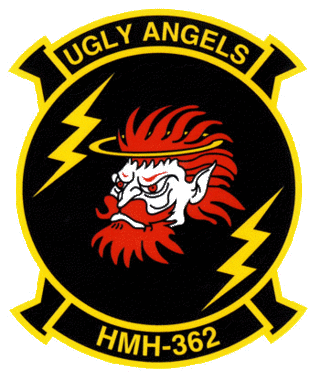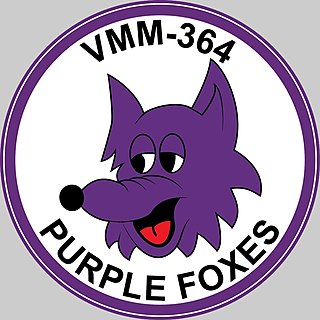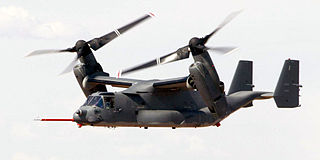
The Sikorsky CH-53E Super Stallion is a heavy-lift helicopter operated by the United States military. As the Sikorsky S-80, it was developed from the CH-53 Sea Stallion, mainly by adding a third engine, adding a seventh blade to the main rotor, and canting the tail rotor 20°. It was built by Sikorsky Aircraft for the United States Marine Corps. The less common MH-53E Sea Dragon fills the United States Navy's need for long-range minesweeping or airborne mine countermeasures missions, and performs heavy-lift duties for the Navy. The Sikorsky CH-53K King Stallion, which has new engines, new composite rotor blades, and a wider aircraft cabin, is set to replace the CH-53E and is beginning to enter service in the 2020s, but most of the Super Stallions are still in service as are the MH-53E Sea Dragons.

The CH-53 Sea Stallion is an American family of heavy-lift transport helicopters designed and built by the American manufacturer Sikorsky Aircraft. The Sea Stallion was originally developed in response to a request from the United States Navy's Bureau of Naval Weapons made in March 1962 for a replacement for the Sikorsky CH-37 Mojave helicopters flown by the United States Marine Corps (USMC).

The Irish Coast Guard is part of the Department of Transport in the Republic of Ireland. The primary roles of the Coast Guard include maritime safety and search and rescue. The Irish Marine Search and Rescue Region (IMSRR) is the area over which the Coast Guard has responsibility. This area is bordered by the UK Search and Rescue Region.

Marine Medium Tiltrotor Squadron 362 (VMM-362) is a United States Marine Corps squadron that operates MV-22 Osprey. The squadron, known as the "Ugly Angels", was reactivated on 17 August 2018 at Marine Corps Air Station Miramar, California.

Marine Medium Tiltrotor Squadron 265 (VMM-265) is a United States Marine Corps assault support transport squadron consisting of MV-22 Osprey tiltrotor aircraft. The squadron, known as the "Dragons", is based at Marine Corps Air Station Futenma, Okinawa, Japan and falls under the command of Marine Aircraft Group 36 (MAG-36) and the 1st Marine Aircraft Wing.

Marine Medium Tiltrotor Squadron 364 (VMM-364) is a United States Marine Corps medium-lift tiltrotor squadron consisting of MV-22B Ospreys. The squadron, known as the "Purple Foxes", is based at Marine Corps Air Station Camp Pendleton, California and falls under the command of Marine Aircraft Group 39 (MAG-39) and the 3rd Marine Aircraft Wing.

Marine Heavy Helicopter Squadron 463 (HMH-463) was a United States Marine Corps helicopter squadron consisting of CH-53E Super Stallion transport helicopters. The squadron, also known as "Pegasus", was last based at Marine Corps Air Station Kaneohe Bay, Hawaii and fell under the command of Marine Aircraft Group 24 (MAG-24) and the 1st Marine Aircraft Wing. HMH-463 was decommissioned in April 2022 as part of the Commandant of the Marine Corps Force Design 2030 initiative.

The Bell Boeing V-22 Osprey is an American military tiltrotor aircraft whose history of accidents have provoked concerns about its safety. The aircraft was developed by Bell Helicopter and Boeing Helicopters; the companies work together to manufacture and support the aircraft.

Marine Corps Air Station Kaneohe Bay or MCAS Kaneohe Bay is a United States Marine Corps (USMC) airfield located within the Marine Corps Base Hawaii complex, formerly known as Marine Corps Air Facility (MCAF) Kaneohe Bay or Naval Air Station (NAS) Kaneohe Bay. It is located two miles northeast of the central business district of Kaneohe, in Honolulu County, Hawaii, United States. The airfield has one runway (4/22) with a 7,771 x 200 ft asphalt surface.

The 2009 California mid-air collision occurred at sea, west of San Diego, on 29 October. It involved a Lockheed HC-130H Hercules of the United States Coast Guard and a Bell AH-1 SuperCobra of the U.S. Marine Corps. There were no survivors among the nine crewmates aboard either aircraft.

In the early hours of 14 March 2017, a Sikorsky S-92 helicopter operated by CHC Helicopter under contract to the Irish Coast Guard crashed into the sea while supporting a rescue operation off County Mayo, on Ireland's west coast. All four crew members on board, Captain Dara Fitzpatrick, Chief Pilot Mark Duffy, winch operator Paul Ormsby, and winch man Ciarán Smith were killed.

The 2005 Al-Anbar CH-53E crash refers to an aviation accident which occurred on January 26, 2005 when a United States Marine Corps CH-53E Super Stallion helicopter crashed while ferrying U.S. military personnel in the Al-Anbar province of western Iraq, near the town of Ar-Rutbah. All thirty-one troops aboard the helicopter died in the crash, which made it the deadliest single incident for U.S. troops during the Iraq War. The accident took place while coalition forces were trying to secure the country ahead of the January 2005 Iraqi parliamentary election slated to take place later that month. The cause of the crash was determined to be the pilots becoming disoriented when they flew into a sandstorm

Transair Flight 810 was a Boeing 737-200 converted freighter aircraft, owned and operated by Rhoades Aviation under the Transair trade name, on a short cargo flight en route from Honolulu International Airport to Kahului Airport on the neighboring Hawaiian island of Maui. Immediately after an early morning takeoff on July 2, 2021, one of its two Pratt & Whitney JT8D turbofan engines faltered, and the first officer, who was flying the aircraft, reduced power to both. The two pilots—who were the only aircraft occupants—began executing the Engine Failure or Shutdown checklist, but became preoccupied with talking to air traffic control (ATC) and performing other flying tasks, and never reached the section of the checklist where the failing engine was to be positively identified and shut down. The captain assumed control but misidentified the failing engine, increased power to that engine, and did not increase power to the other, properly functioning engine. Convinced that neither engine was working properly and unable to maintain altitude with one engine faltering and the other idling, the pilots ditched off the coast of Oahu about 11 minutes into the flight.

On 17 February 1956 in California a United States Marine Corps Douglas R5D-2 Skymaster flying from Marine Corps Air Station El Toro to Naval Air Station Alameda crashed on approach north of Niles Canyon, about 3.5 miles (5.6 km) northeast of Niles, California. All 35 marines and 5 crew members died. A Marine Corps board of inquiry determined that the flight crew made multiple mistakes.















